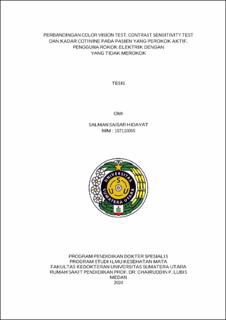| dc.description.abstract | Introduction: Toxic optic neuropathy is marked by symmetrical, bilateral, painless vision loss, scotoma, visual field defects, and color vision deficits. The WHO estimates smoking will cause nearly 9 million deaths annually by 2030. In Indonesia, the smoking prevalence among 15-year- olds has risen to 36.3%, up from 27% in 1995, making it the third largest smoking population globally, after China and India.
Aim: To compare color vision test results, contrast sensitivity, and cotinine levels among active smokers, e-cigarette users, and non-smokers.
Methods: This observational analytic study used a cross-sectional approach with data from color vision tests, contrast sensitivity tests, cotinine levels, and interviews among Medan city residents, North Sumatra. Univariate analysis assessed age and cotinine levels using mean, median, standard deviation, and range. Nominal variables such as gender and smoking status were analyzed with counts and percentages. Bivariate analysis compared cotinine levels across groups using independent T-tests for normally distributed data.
Results: Among conventional smokers, 10% showed decreased contrast sensitivity, while 90% had normal results. Kruskal-Wallis test revealed no significant difference in contrast sensitivity between conventional smokers, e-cigarette users, and non-smokers (p = 0.131). In conventional smokers, cotinine levels were 23.3 ng/mL for those with decreased contrast sensitivity, compared to 16.78 ng/mL for those with normal sensitivity (p = 0.044).
Conclusion: Cotinine levels are significantly related to contrast sensitivity in conventional smokers. | en_US |


